Ijraset Journal For Research in Applied Science and Engineering Technology
- Home / Ijraset
- On This Page
- Abstract
- Introduction
- Conclusion
- References
- Copyright
Preparation of Choco Dates Bar
Authors: Aman Ashok Baiswar , Parimal Vijay Korekar, Nishant Anil Barde, Divya Korde, Prashant Watkar, Pranay Chandrakant Pachbhai
DOI Link: https://doi.org/10.22214/ijraset.2024.62188
Certificate: View Certificate
Abstract
We aimed to produce dates bar by using of dates, standard procedure we adopted for preparing the Choco dates bar. However, in this study, product was devoid of any sweet additives, as dates are rich in natural sugar. Various analysis (proximate composition moisture and Ash, color, texture profile and sensory quality evolution) Were performed to evaluate the overall virtues of dates-based bar to be rich in protein, Fat and carbohydrates with good energy values. The Radical was observed in bars compared to raw dates. Texture wise, product had high factor- ability, indicating easy to bite and chew nature thus rendering it suitable for elderly people and small children. result of sensory quality evolution indicated dates have evolutes potential to be converted into bars. Result generated in this study suggests date-based bars maybe expected to fulfill the requirement of heart conscious consumers. it is anticipated that the ‘CHOCO DATES BAR\' attract better marketability at the international level.
Introduction
I. INTRODUCTION
The palm date tree, Phoenix dactylifera L., belonging to the Arecaceae family, plays a crucial role in the economies and diets of the Middle East and North Africa . Saudi Arabia (SA) stands as the world's second-largest producer of palm dates, contributing nearly 16% to the global date fruit supply, with a cultivation of 450 date palm cultivars . Choco dates bars are a delicious and nutritious snack made with a combination of chocolate and dates. They often provide a natural sweetness from the dates and the rich flavor of chocolate. It's a popular choice for those looking for a healthier alternative to traditional chocolate bars. Choco dates bars represent a delightful fusion of natural sweetness and indulgent flavor. Crafted by combining the wholesome richness of dates with the luscious taste of chocolate, these bars offer a unique and satisfying treat. In response to the growing demand for healthier snack options, Choco dates bars have emerged as a popular choice, providing a delectable alternative to traditional chocolate bars. This introduction aims to explore the appeal and characteristics of Choco dates bars, highlighting their potential to cater to a discerning market seeking both taste and nutritional benefits.
This paper delves into the nutritional composition and sensory appeal of Choco dates bars, a burgeoning category within the snack industry. Fusing the natural sweetness of dates with the decadence of chocolate, these bars have gained popularity as a potential healthier alternative to conventional chocolate bars. The study aims to analyze the nutritional benefits, including fiber content and antioxidants derived from dates, and assess how these factors contribute to the perceived healthiness of Choco dates bars. Additionally, sensory evaluations will be conducted to understand the taste, texture, and overall palatability, investigating the factors that contribute to consumer preference. The research outcomes aim to provide insights into the market potential, consumer acceptance, and the positioning of Choco dates bars in the context of contemporary health-conscious lifestyles.
II. MATERIALS AND METHODOLOGY
- Raw Materials: This section typically outlines the material used and the procedures followed during the study. It describes the equipment, instruments, reagents and samples used, also the experiments used to collect and analyze data. New product development work was carried out at the Department of Food Technology, Ballarpur Institute of Technology, Bamni, Ballarpur.
Table 1: Material Required for New Product Development
|
Material Required |
Collection of Raw Material |
|
Dates |
Super market |
|
Dark compound |
Super market |
|
Oats |
Super market |
|
Almonds |
Super market |
|
Choco Powder |
Super market |
|
Butter |
Super market |
|
Essence |
Super market |
2. Equipments:- The below table shows the equipments required for the new product development
Table No. 2 Equipments Required For New Product Development
|
Equipments Required |
Collection of Raw Material |
|
Chocolate mold |
Home |
|
Parchment paper |
Home |
|
Microwave |
Processing lab |
|
Refrigerator |
Processing lab |
|
Measuring cups |
Processing lab |
|
Induction |
Processing lab |
|
Spatula |
Processing lab |
|
Weighing machine |
Processing lab |
|
Knife |
Processing lab |
3. Methodology
Ingredient selection: High quality dates along with complementary ingredients such as dark compound, oats, almonds, Choco powder, butter, essence to achieve optimal taste.
4. Flow sheet of preparation of Choco Dates Bar:
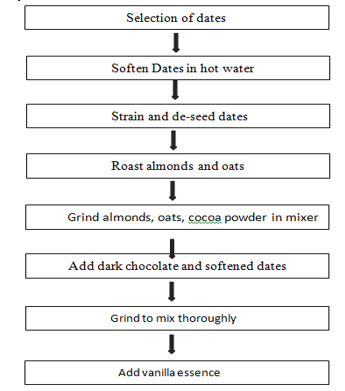
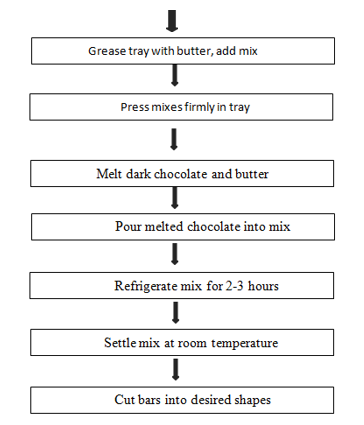
5. Sensory Analysis: Sensory analysis was conducted in the campus of Ballarpur Institute of Technology by a sensory testing consisting of color, appearance, flavor, texture, taste and overall acceptability of product and rated them in a scale of 0 to 10 with 0 as the minimum and 10 as the maximum.
6. Proximate Analysis:
7. Estimation of Moisture:
The moisture content was analyzed using the Oven drying method. About 5 grams of each sample were weighed on pre-weighed petri plates and placed in an oven set at 105°C for 3 hours. Once dried, the samples were cooled in airtight desiccators to prevent moisture exchange. The drying process was deemed finished when two consecutive weighings, taken an hour apart, showed variations of no more than 5 mg. Moisture content was determined by subtracting the final dried weight from the initial sample weight and expressed as a percentage .%Moisture= (Loss in weight x 100)/ (weight of sample)
8. Estimation of fat:
A 5-gram sample was first weighed and then placed within a thimble for containment. The thimble, now housing the sample, underwent an additional weighing to confirm the sample's weight. Next, this thimble, along with the sample, was inserted into a larger cellulose thimble. This combined setup was then carefully positioned within a Soxhlet extraction tube. To initiate the extraction process, 250 ml of petroleum ether was introduced into the Soxhlet extraction tube containing the sample. Once the heating mantle was activated and the temperature set to 60°C, the petroleum ether underwent a cycle of evaporation, condensation, and dripping over the sample at a controlled rate of 150 drops per minute. Upon observing clear petroleum ether in the Soxhlet after 6-12 hours, the entire assembly was deactivated. Subsequently, the round bottom flask containing the solvent was separated from the apparatus to recover the solvent.
The recovered solvent underwent further processing using a downward distillation unit for subsequent use. Meanwhile, the round bottom flask containing the extracted fat sample underwent a drying process in a hot air oven set at 105°C until all the solvent was completely removed. Following drying, the round bottom flask was cooled in a desiccator, and its weight was measured until three successive readings showed a difference of less than 0.001 grams [AOAC (1995)Assocoation of Official Analytical Chemists, Washington DC]. The percent crude fat was calculated as per the AOAC method.
% Crude Fat= (weight of fat)/(weight of sample) x100
9. Estimation of protein:
The protein content of the samples was determined using the Kjeldahl method. Initially, a 2-gram sample underwent digestion with a digestion mixture consisting of 5 grams, comprising 10 parts potassium sulfate and 1 part copper sulfate, along with 20 ml of concentrated sulfuric acid. This digestion process continued in a Kjeldahl flask until the contents achieved a state of being carbon-free. Following digestion, the resulting digested sample was then adjusted to a final volume of 100 ml.
A 10 ml aliquot of the digested sample was subjected to distillation with 20 ml of 30 percent sodium hydroxide. The liberated ammonia from this process was collected in a solution containing 20 ml of 2 percent boric acid, enriched with 2-3 drops of a mixed indicator. This indicator was a combination of 0.1% methyl red and 0.1% bromo-cresol green, dissolved in 95 percent ethyl alcohol, with a ratio of 1:5, respectively. The entrapped ammonia was subsequently titrated against 0.1N hydrochloric acid.
The nitrogen content in the sample was then calculated using the following expression:
% Nitrogen = (14 x N of HCL x Titre value (ml)× Dilution factor x 100)/ (Weight of sample (g)x100)
10. Estimation of Total Ash:
To determine the ash content, a 2-gram sample was deposited into a silica crucible and ignited over a heater. Later, the crucible was moved to a muffle furnace and kept at 550°C ± 15°C until a pure ash was acquired. The weight of the resultant residue was then noted, and the percentage of ash was calculated using the subsequent formula:
%Ash = (weight of residue x 100)/ (weight of sample)
11. Estimation of carbohydrates:
The percent carbohydrates were calculated by subtracting the sum of moisture, protein, fat, ash and fiber from 100.
% CHO = 100- (% Moisture +% Protein+% Fiber+%+ Ash
12. Microbial Analysis:
The Total bacterial count and fungal load was estimated by serial dilution method.
13. Shelf-life testing:
Shelf life was estimated based on microbial and sensory analysis at intervals of 5 months.
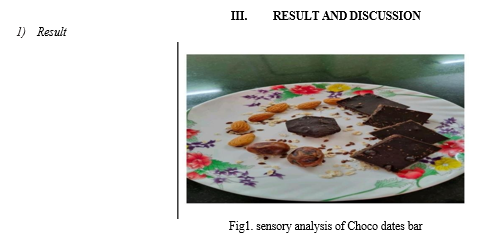
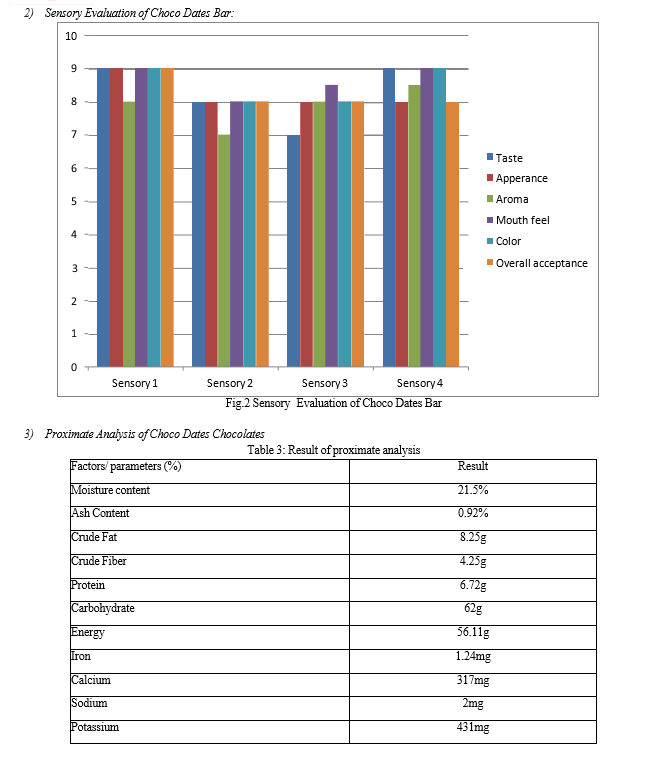
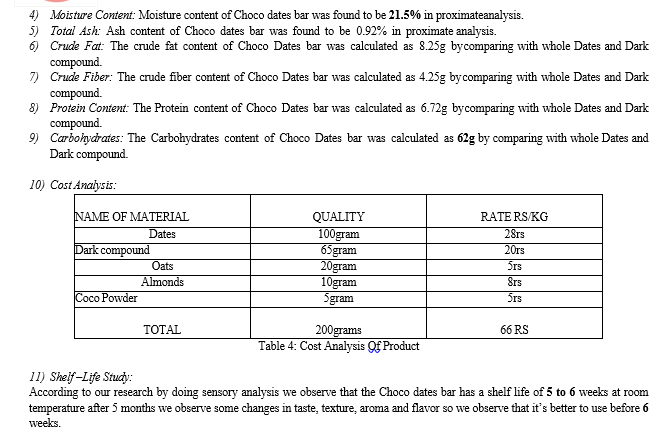
Conclusion
\"The present investigation entitled \'Choco date bar\' by using dates, and rousted almond, and oats was carried out in the Department of Food Technology at Ballarpur Institute of Technology, Dr. Babasaheb Ambedkar Technical University, Lonere (Maharashtra, India). The experiment was conducted to develop Choco Dates Bars by incorporation of almond, oats, and date with different composition. It can be concluded that date and almond can be incorporated in suitable proportion in the date bar, which has many health benefits. From the above study, it has been found that with highly nutritious and rich vitamin E minerals including magnesium, iron, calcium, can be prepared by dates, oats, and almondin good texture and taste of Choco date bar is improved by change in proportionof almonds and date as per sensory evaluation carried out. Almond contains a significant amount of protein, but unlike other nuts, they provide protein that is mostly in the form of median change saturated fatty acids.\"
References
[1] Ruth Vanderschueren, David Arguello, Hesteer Blommaert, Daniela Montalvo, Fiorella Barraza Science of the total Environment 781, 146779, 2021. [2] Binaifer Bedford, Ye Yu, Xue Wang, Eric AE Garber, Lauren S Jackson Journal of Food Protection 692-702, 2017. [3] Inni Fatmawati, Putri Ronitawati, Vitria Melani, Nazhif Gifari,Rachmanida Nuzrina Journal of Functional Food and Nutraceutical, 119-126, 2020. [4] Sulaiman Aljaloud, Heather L Colleran, Salam A Ibrahim Food and Nutrition Sciences 463, 2020. [5] Mayur Chandegara, Bandana Chatterjee, Neha Sewani International Journal of Food and Fermentation Technology 93-97,2018. [6] Muhammad Nadeem, Faqir Muhammad Anjum, Mian Anjum Murtaza, Ghulam Mueen-ud-Din The Scientific World Journal 2012, 2012. [7] Irshad, Asif & Solangi, Khaleel & Marri, Asadullah & Shaikh, Nida & Khan, Alam & Dawood, Muhammad. (2022). Fortification of Date Bars with Different Protein Sources and their Nutritional Profiling. Pakistan Journal of Scientific and Industrial Research. 65. 129-134. [8] Alfheeaid, Hani & Barakat, Hassan & Althwab, Sami A. & Musa, Khalid Hamid & Malkova, Dalia. (2023). Nutritional and Physicochemical Characteristics of Innovative High Energy and Protein Fruit- and Date-Based Bars. Foods. 12. 2777. 10.3390/foods12142777. [9] Satifa, Tiara & Bahar, Asrul. (2023). Substitution of Tempeh and Adition of Dates in The Manufacture of Snack Bar as High Protein and Iron Snack. International Journal on Food, Agriculture and Natural Resources. 4. 27-31. 10.46676/ij-fanres.v4i3.157. [10] Ayivi, Raphael & Ibrahim, Salam & Ayad, Amira & Williams, Leonard & Gyawali, Rabin & Krastanov, Albert & Aljaloud, Sulaiman. (2020). Date fruit: A review of the chemical and nutritional compounds, functional effects and food application in nutrition bars for athletes. 10.1111/ijfs.14783 [11] Lieb, Veronika & Kleiber, Caroline & Metwali, Ehab & Kadasa, Naif & Almaghrabi, Omar & Steingass, Christof & Carle, Reinhold. (2020). Fatty acids and triacylglycerols in the seed oils of Saudi Arabian date (Phoenix dactylifera L.) palms. International Journal of Food Science & Technology. 55. 1572–1577. 10.1111/ijfs.14383. [12] Agamy, Neveen & Hegazy, Eman & Younes, Nashwa & El-Hossainy, Ahmed. (2023). Nutritional, Safety and Sensory Evaluation of Innovative Siwi Date Snacks with Flavors and Fillings. Journal of High Institute of Public Health. 53. 114-125. 10.21608/jhiph.2024.345880.
Copyright
Copyright © 2024 Aman Ashok Baiswar , Parimal Vijay Korekar, Nishant Anil Barde, Divya Korde, Prashant Watkar, Pranay Chandrakant Pachbhai. This is an open access article distributed under the Creative Commons Attribution License, which permits unrestricted use, distribution, and reproduction in any medium, provided the original work is properly cited.

Download Paper
Paper Id : IJRASET62188
Publish Date : 2024-05-15
ISSN : 2321-9653
Publisher Name : IJRASET
DOI Link : Click Here
 Submit Paper Online
Submit Paper Online

